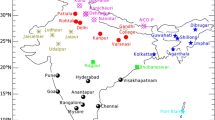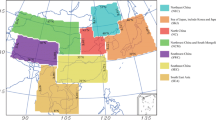Abstract
The air quality model system RAMS (Regional Atmospheric Modeling System)-CMAQ (Models-3 Community Multi-scale Air Quality) coupled with an aerosol optical/radiative module was applied to investigate the impact of different aerosol mixing states (i.e., externally mixed, half externally and half internally mixed, and internally mixed) on radiative forcing in East Asia. The simulation results show that the aerosol optical depth (AOD) generally increased when the aerosol mixing state changed from externally mixed to internally mixed, while the single scattering albedo (SSA) decreased. Therefore, the scattering and absorption properties of aerosols can be significantly affected by the change of aerosol mixing states. Comparison of simulated and observed SSAs at five AERONET (Aerosol Robotic Network) sites suggests that SSA could be better estimated by considering aerosol particles to be internally mixed. Model analysis indicates that the impact of aerosol mixing state upon aerosol direct radiative forcing (DRF) is complex. Generally, the cooling effect of aerosols over East Asia are enhanced in the northern part of East Asia (Northern China, Korean peninsula, and the surrounding area of Japan) and are reduced in the southern part of East Asia (Sichuan Basin and Southeast China) by internal mixing process, and the variation range can reach ±5 W m−2. The analysis shows that the internal mixing between inorganic salt and dust is likely the main reason that the cooling effect strengthens. Conversely, the internal mixture of anthropogenic aerosols, including sulfate, nitrate, ammonium, black carbon, and organic carbon, could obviously weaken the cooling effect.
Similar content being viewed by others
References
Adachi, K., and P. Buseck, 2008: Internally mixed soot, sulfates, and organic matter in aerosol particles from Mexico City. Atmos. Chem. Phys., 7, 1645–1655.
Benkovitz, C. M., and Coauthors, 1996: Global gridded inventories of anthropogenic emissions of sulfur and nitrogen. J. Geophys. Res., 101(29), 239–253.
Berner, A., S. Sidla, Z. Galambos, C. Kruisz, R. Hitzenberger, H. Brink, and G. Kos, 1996: Model character of atmospheric black carbon size distributions. J. Geophys. Res., 101, 19559–19565.
Binkowski, F. S., and U. Shankar, 1995: The regional particulate model. 1, Model description and preliminary results. J. Geophys. Res., 100, 26191–26209.
Bond, T., G. Habib, and R. Bergstrom, 2006: Limitations in the enhancement of visible light absorption due to mixing state. J. Geophys. Res., 111, doi: 10.1029/2006JD007315.
Carmichael, G. R., and Coauthors, 2008: MICS-Asia II: The model intercomparison study for Asia Phase II methodology and overview of findings. Atmos. Environ., 42(15), 3468–3490.
Chen, J., and I. Tsai, 2010. Aerosol mixture state simulated with a physically-based three-moment multimodal aerosol parameterization scheme. Abstracts, AGU Fall Meeting, San Francisco, American Geophysical Union, Vol.1, 192.
Chuang, C., J. Penner, J. Prospero, K. Grant, G. Rau, and K. Kawamoto, 2002: Cloud susceptibility and the first aerosol indirect forcing: Sensitivity to black carbon and aerosol concentrations. J. Geophys. Res., 107, doi: 10.1029/2000JD000215.
Gong, S. L., 2003: A parameterization of sea-salt aerosol source function for sub- and super-micron particles. Global Biogeochemcal Cycles, 17(4), doi: 10.1029/2003GB002079.
Han, X., M. Zhang, Z. Han, J. Xin, and X. Liu, 2011: Simulation of aerosol direct radiative forcing with RAMS-CMAQ in East Asia. Atmos. Environ., 45(36), 6576–6592.
Han, X., C. Ge, J. Tao, M. Zhang, and R. Zhang, 2012a: Air quality modeling for a strong dust event in East Asia in March 2010. Aerosol and Air Quality Research, 12, 615–628.
Han, Z., H. Ueda, K. Matsuda, R. Zhang, K. Arao, Y. Kanai, and H. Hasome, 2004: Model study on parti cle size segregation and deposition during Asian dust events in March 2002. J. Geophys. Res., 109, doi: 10.1029/2004JD004920.
Han, Z., H. Ueda, and T. Sakurai, 2006: Model study on acidifying wet deposition in East Asia during wintertime. Atmos. Environ., 40(13), 2360–2373.
Han, Z., J. Li, X. Xia, and R. Zhang, 2012b: Investigation of direct radiative effects of aerosols in dust storm season over East Asia with an online coupled regional climate-chemistry-aerosol model. Atmos. Environ., 54, 688–699.
IPCC, 2007: Changes in atmospheric constituents and in radiative forcing. Climate Change 2007: Cambridge University Press, New York, 94pp.
Jacobson, M., 1997: Development and application of a new air pollution modeling system, Part III, Aerosolphase simulations. Atmos. Environ., 31, 287–608.
Jacobson, M., 2001: Strong radiative heating due to the mixing state of black carbon in atmospheric aerosols. Nature, 409, 695–697.
Lesins, G., P. Chylek, and U. Lohmann, 2002: A study of internal and external mixing scenarios and its effect on aerosol optical properties and direct radiative forcing. J. Geophys. Res., 107, doi: 10.1029/2001JD000973.
Liu, X., J. E. Penner, and M. Herzog, 2005: Global modeling of aerosol dynamics: Model description, evaluation, and interactions between sulfate and nonsulfate aerosols. J. Geophys. Res., 110, D18206, doi: 10.1029/2004JD005674.
Moteki, N., and Coauthors, 2007: Evolution of mixing state of black carbon particles: Aircraft measurements over the western Pacific in March 2004. Geophys. Res. Lett., 34, doi: 10.1029/2006GL028943.
Nenes, A., C. Pilinis, and S. Pandis, 1999: Continued development and testing of a new thermodynamic aerosol module for urban and regional air quality models. Atmos. Environ., 33, 1553–1560.
Olivier, J., A. Bouwman, C. Maas, and J. Berdowski, 1994: Emission database for global atmospheric research. Environmental Monitoring and Assessment, 31(1–2), 93–106.
Pfiser, G., L. Emmons, P. Hess, J. Lamarque, A. Thompson, and J. Yorks, 2008: Analysis of the summer 2004 ozone budget over the United States using intercontinental transport experiment Ozonesonde network study (IONS) observations and model of ozone and related tracers (MOZART-4) simulations. J. Geophys. Res., 113, D23306, doi: 10.1029/2008JD010190.
Qian, Y., L. R. Leung, S. J. Ghan, and F. Giorgi, 2003: Regional climate effects of aerosol over China: Modeling and observation. Tellus B, 55, 914–934.
Sarwar, G., D. Luecken, G. Yarwood, G. Whitten, and W. Carter, 2008: Impact of an updated carbon bond mechanism on predictions from the CMAQ modeling system: Preliminary assessment. J. Appl. Meteor. Climatol., 47, 3–14.
Schulz, M., and Coauthors, 2006: Radiative forcing by aerosols as derived from the AeroCom present-day and pre-industrial simulations. Atmos. Chem. Phys., 6, 5225–5246, doi: 10.5194/acp-6-5225-2006.
Shiraiwa, M., Y. Kondo, N. Moteki, N. Takegawa, Y. Miyazaki, and D. Blake, 2007: Evolution of mixing state of black carbon in polluted air from Tokyo. Geophys. Res. Lett., 34, doi: 10.1029/2007GL029819.
Streets, D. G., and Coauthors, 2003: An inventory of gaseous and primary aerosol emissions in Asia in the year 2000. J. Geophys. Res., 108(D21), doi: 10.1029/2002JD003093.
Sun, J., M. Zhang, and T. Liu, 2001: Spatial and temporal distribution of dust storms in China and its surrounding regions, 1960–1999: Relations to source area and climate. J. Geophys. Res., 106, 10325–10333.
Wang, T., J. Min, Y. Xu, and K. Lam, 2003: Seasonal variations of anthropogenic sulfate aerosol and direct radiative forcing over China. Meteor. Atmos. Phys., 84, 185–198.
Wu, J., W. Jiang, H. Liu, and J. Tang, 2002. Simulation of the direct and indirect radiative effects of sulfate aerosol. Acta Scientiae Circumstantiae, 22, 129–134. (in Chinese)
Zhang, M., 2004: Modeling of organic carbon aerosol distributions over East Asia in the springtime. China Particuology, 2, 192–195.
Zhang, M., and Coauthors, 2004: Transport and transformation of sulfur compounds over East Asia during the TRACE-P and ACE-Asia campaigns. Atmos. Environ., 38, 6947–6959.
Zhang, M., Y. Xu, R. Zhang, and Z. Han, 2005: Emission and concentration distributions of black carbon aerosol in East Asia during springtime. Chinese Journal of Geophysics, 48(1), 55–61. (in Chinese)
Zhang, M., L. Gao, C. Ge, and Y. Xu, 2007a: Simulation of nitrate aerosol concentrations over East Asia with the model system RAMS-CMAQ. Tellus B, 59, 372–380.
Zhang, R., J. Cao, S. Lee., Z. Shen, and K. Ho, 2007b: Carbonaceous aerosols in PM10 and pollution gases in winter in Beijing. Journal of Environmental Sciences, 19(5), 564–571.
Author information
Authors and Affiliations
Corresponding author
Rights and permissions
About this article
Cite this article
Han, X., Zhang, M., Zhu, L. et al. Model analysis of influences of aerosol mixing state upon its optical properties in East Asia. Adv. Atmos. Sci. 30, 1201–1212 (2013). https://doi.org/10.1007/s00376-012-2150-4
Received:
Revised:
Accepted:
Published:
Issue Date:
DOI: https://doi.org/10.1007/s00376-012-2150-4




